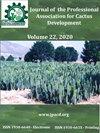Carmine cochineal: fortune wasted in northern Ethiopia Tesfay Belay
IF 0.4
4区 农林科学
Q4 HORTICULTURE
Journal of the Professional Association for Cactus Development
Pub Date : 2020-06-20
DOI:10.56890/jpacd.v17i.62
引用次数: 4
Abstract
Carmine cochineal, Dactylopius coccus Costa, was introduced to northern Ethiopia to addconsiderable value to existing cactus pear vegetation that in places like the southern Tigraywas becoming an invasive plant. It became an investment opportunity where Foodsafe, aChilean company was involved. Company was granted 300 ha at the cactus pear infestedplains of southern Tigray. Foodsafe was also expected to expand cochineal productionthrough an outgrower scheme. It created employment opportunity for the locals and startedexporting dried cochineal to Mexico and Germany bringing in foreign currency. As cactuspear grows in communal lands, conflict of interest arose and it polarised the community. Thecompany was forcibly closed and it was a tragedy that a one time commercial insect becamea full-fledged invasive insect pest. Attempts to contain the insect with mechanical andchemical control were not successful. So far more than 16,000 ha of cactus pear land wasinfested with carmine cochineal. 13,000 ton of dried cochineal could have been harvested ina single year, generated USD $52 million, and part of that money could have been used forits management.胭脂红胭脂红:在埃塞俄比亚北部浪费的财富
胭脂虫(Dactylopius coccus Costa)被引入埃塞俄比亚北部,为现有的仙人掌梨植被增加了相当大的价值,在提格雷南部等地,仙人掌梨植被正成为一种入侵植物。这成为了一个投资机会,一家智利公司Foodsafe也参与其中。该公司在提格雷南部仙人掌梨产区获得了300公顷的土地。预计Foodsafe还将通过种植计划扩大胭脂虫的产量。它为当地人创造了就业机会,并开始将胭脂虫干出口到墨西哥和德国,带来外汇。随着仙人掌生长在公共土地上,利益冲突出现,社区两极分化。该公司被强制关闭,一种曾经的商业昆虫变成了一种全面的入侵害虫,这是一场悲剧。用机械和化学方法控制这种昆虫的尝试没有成功。到目前为止,超过16000公顷的仙人掌梨地上长满了胭脂虫。每年可以收获13000吨胭脂虫干,产生5200万美元,其中一部分资金可以用于管理。
本文章由计算机程序翻译,如有差异,请以英文原文为准。
求助全文
约1分钟内获得全文
求助全文
来源期刊

Journal of the Professional Association for Cactus Development
Agricultural and Biological Sciences-Plant Science
CiteScore
1.10
自引率
33.30%
发文量
10
期刊介绍:
The editors of the Journal of the Professional Association for Cactus Development, are very excited to be a part of the excellent editorial committee and to work together to create the synergism between scientists, growers, legislators, and business people so vital to the development of this industry to serve the people of arid lands.
 求助内容:
求助内容: 应助结果提醒方式:
应助结果提醒方式:


